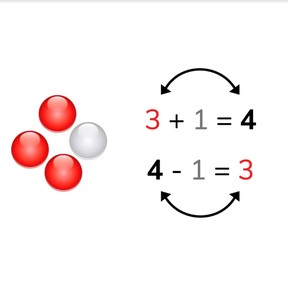



8,000 schools use Gynzy
92,000 teachers use Gynzy
1,600,000 students use Gynzy
General
Students learn to subtract numbers to 10 using inverse operation. They learn that each subtraction number has a partner addition problem, which they can use to solve the subtraction problem.
Common core standard(s)
1.OA.C.6
1.OA.A
Relevance
This strategy helps make subtraction easier and faster. It helps ground basic calculations with numbers to 10.
Introduction
Start by decomposing the numbers given on the interactive whiteboard. Then discuss the number bonds for the numbers given on the interactive whiteboard. You may also encourage students to use blocks to help represent these decompositions/number bonds. Do a few number decompositions orally with the class. For example: " I decompose the number 5 into 4 and ...". Then determine which math problems are shown in the images on the interactive whiteboard. You see 6 fish in total, of which 1 is in the fish tank and 5 are in a fishbowl. This could represent 6 - 1 or 5 + 1. Discuss with students why the other options are incorrect (for example 5 - 1 is incorrect, because the total amount of fish shown is 6, not 5).
Development
Explain to students that if they know an addition problem, that they also know the subtraction problem. The numbers in the problems are simply in different places in the problem. With a subtraction problem, you start with the total or sum of the addition problem. If you subtract or take away one of the numbers, your difference is the second number. Show this with the beads on the interactive whiteboard. Then practice this with a new set of beads. Then show a decomposition of the number 5 and the math problems you can create with these decompositions. Practice this with students using different decompositions. After practicing this with students using numbers that have visual support, explain that this does not change, even if you can't count the object(s). Practice using the inverse operation with decompositions where only numbers are visible.
Check that students understand subtraction to 10 via the inverse operation by asking the following questions:
- You can decompose 8 into 2 and ...?
- 7 + 2 = 9. What is 9 - 2?
- Which number do you set as the first number when you turn an addition problem into a subtraction problem?
- Which numbers can swap places?
Guided practice
Students are first given problems with visual support, then are given a number bond as support, and finally are asked to solve problems without any visual support. They must fill in the correct answers.
Closing
Discuss with students that it is important to be able to use the inverse operation so that they can easily and quickly solve math problems. For example, if you know that there are 2 cats and 3 dogs at the house, the total is 5 pets. You then also know that if you are at that house and see 2 cats, there are 3 dogs left to find. To close, ask students to solve a set of problems with visual support, and finally a set of problems without visual support.
Teaching tips
Students who have difficulty can be supported by making use of manipulatives like MAB blocks or a rekenrek. For example: Have them count out 7 blocks and split them into a gorup of 4 and 3. Ask them to say what the addition problem is (3 + 4 = 7). Then ask them how many blocks are left if you take away 3 blocks. Point out to the students that they don't need to recalculate, because you already know how many blocks are needed from the addition problem you just solved.
Instruction materials
Optional: MAB blocks, rekenrek
The online teaching platform for interactive whiteboards and displays in schools
Save time building lessons
Manage the classroom more efficiently
Increase student engagement
Discover more!
About Gynzy
Gynzy is an online teaching platform for interactive whiteboards and displays in schools.
With a focus on elementary education, Gynzy’s Whiteboard, digital tools, and activities make it easy for teachers to save time building lessons, increase student engagement, and make classroom management more efficient.



